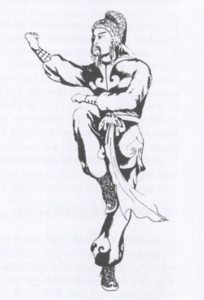The Northern Shaolin Seven-Star Praying Mantis System is one of the great fighting systems of kung fu. According to tradition, the founder of the style was Wang Lang, an unshaven monk of the Henan Shaolin Temple. Wang Lang was a native of Shandong Province. He came from a wealthy family and studied the martial arts in his youth. Wang Lang entered the Shaolin Monastery around 350-400 years ago, in the period between the Ming (1368-1644) and the Ching (1644-1911) Dynasties. It was a time of chaos for China, with the Manchus committing many atrocities. The Manchus were Mongoloid people of Manchuria, who conquered China in the 17th century, establishing an imperial dynasty that lasted until 1912. At Shaolin, Wang Lang would train with his kung fu brothers. Although he had obtained the techniques of seventeen different kung fu styles, he still could not defeat the other monks.
One day while out walking, Wang Lang witnessed a fight between a mantis and a cicada. Although at first glance it would appear that the small mantis had a distinct disadvantage against such a large insect, it fought with great courage. Wang Lang was fascinated by the aggressiveness, speed and strength of the apparently overmatched mantis. When the cicada attacked, the mantis would angle its body to the side, and with lightning speed and strength, it would pin the cicada with its powerful forearms. Wang Lang took the mantis back to his living quarters for further study. He used a reed to prod the mantis and carefully study its movements, examining how it reacted to various situations. Wang Lang would then imitate these actions, and over time, the system slowly evolved. This led to the development of the Mantis Style of Kung Fu, with its characteristic strong and rapid movements.
When Wang Lang was satisfied, he added to the new style the best techniques from the other seventeen styles which he had previously studied. He would later also combine the footwork of the monkey. Wang continued training and researching to further improve the skills of this new style. On leaving the Shaolin Monastery, Wang returned to Shandong and helped to establish a temple at Laoshan. The Seven-Star Mantis Style takes its name from the Big Dipper star constellation.
The first generation successor was Shen Xiao Dao Ren, who practiced diligently and mastered the complete system. Shen Xiao Dao Ren became friendly with a security guard named Li San Jian (second generation) after helping him defeat a number of bandits. As their friendship grew and seeing that Li San Jian was a sincere man, Shen Xiao Dao Ren taught him the complete system of Seven-Star Mantis. Returning to his security work, Li San Jian became famous for his “Lightning Fists.”
At the age of 60, he returned home to Shandong Province where he met Wang Rong Sheng (third generation), who was a national kung fu champion. It is said that Wang Rong Sheng was giving a demonstration of his skills when Li San Jian made some offhand remarks about his kung fu abilities. This enraged Wang Rong Sheng, and he immediately challenged the old man. In the ensuing contest, Wang Rong Sheng could not dent the old man’s defenses. Seeing that his kung fu was of such a high level, Wang Rong Sheng begged to be accepted as a disciple. Wang Rong Sheng came from a wealthy family and never taught the art openly.
Later in life, Wang Rong Sheng accepted a disciple by the name of Fan Xu Dong (fourth generation). Fan Xu Dong was born in Ji Mo County of Shandong Province. Fan Xu Dong was a giant of a man, weighing some 280 pounds. His skill with “iron-sand palm” was known over a large area. It is said that he used this technique to kill two charging bulls, and in 1870, he defeated a Russian strongman in a contest that took place in Siberia. This made him a national hero with the nickname “the giant with the broadsword.” Fan Xu Dong taught openly and had many students. Notable amongst these was Luo Guang Yu (fifth generation).
Please click here to view our lineage.

